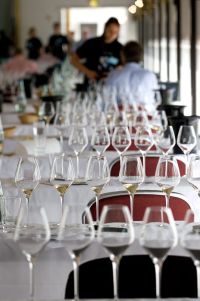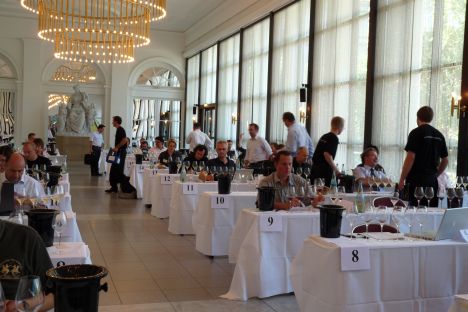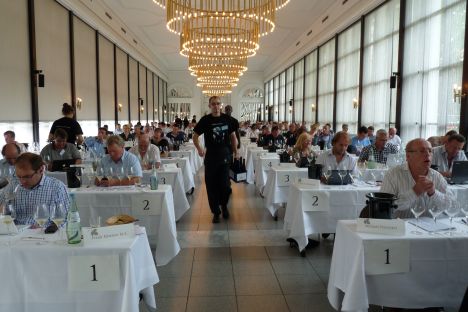Since 2004, the tasting of the current Grosses Gewächse (GG) has taken place in the Kurhaus-Kolonnaden in Wiesbaden. For wine journalists, specialist retailers and sommeliers from all over Europe, this is an excellent opportunity to get an overview of the vintages soon to be on sale. You can't organise such an event much more professionally. The VDP receives effusive praise from all sides here.
The wines on display, on the other hand, give me a headache. At the risk of incurring the wrath or ignorance of many colleagues, more and more wines are in a condition that makes them very difficult to evaluate. Oxidative barrel samples, enormous amounts ofCO2 and sulphur, clear bottle sickness, and yet everyone acts as if nothing is wrong.
 |
| (Photo: VDP / Yutaka Kitajima) |
This comment only applies to the white Burgundy varieties, the Silvaner and the Rieslings of the Baden, Franconia and Württemberg regions. But it also applies to some red wines and certainly to many Rieslings from the classic regions. However, I have not tasted them and cannot make a definitive statement.
For a few years now, it seems that more and more white GGs are being presented in Wiesbaden in a condition that is very questionable. No, I don't mean the quality itself. I can't mean the quality itself, because it is rarely found in bottles in Wiesbaden. So what do I do in the Kurhaus-Kolonnaden in Wiesbaden? Well, desperately looking for wines that are in a meaningful condition. At least you want to be allowed to taste the core, the character and the rough direction.
Some barrel samples are on site, many imponderables immediately in the luggage. Barrel samples can vary extremely. If only because it is difficult for the winemaker to adjust the sulphur content of the barrel sample. Too high means extremely closed wines that taste hard and flat. Too low means there is a risk of an oxidised wine. To this end, barrel samples, once opened and in contact with air, degrade much more quickly. The same applies to the closed bottle, where caution is sometimes required after just a few days. Transport with shaking and different temperatures is an additional stress for the barrel samples. Five barrel samples from one barrique or tank can present themselves as five very different wines. Anyone who has been to the Primeurs in Bordeaux can tell you a thing or two about this.
Brachial sulphur, vast amounts ofCO2 or fermentation that is still in its very last stages make no sense for either the wineries or the tasters. If screwdrivers or glass closures are also involved, the situation gets even worse in the proverbial sense. Restless and completely out of control. It's a mystery how you can smell or taste anything at all in wines with pungent sulphur. There is only sulphur and not much else. It surrounds every aroma molecule and keeps all aromas under quarantine, so to speak. If London is covered in fog, the sun doesn't stand a chance.
Or how is it possible to recognise the style of the wine with so much dissolvedCO2, perhaps because it was filled only the day before? It just bubbles away on the palate. And when tasting, the bubbles burst in the mouth, release theCO2 and these block the receptors in the mouth for the time being. The result is very similar tasting wines. Here, too, transport is a factor that first dissolves theCO2 that is normally bound in the wine.
 |
| (Photo: VDP) |
The statements of some of those present - all imaginable aromas are praised - are astonishing. Apparently, people are talking about wines that definitely cannot have bottle sickness or too much sulphur. Wines are praised for how excellent they are, showing terroir and the winemaker's signature. Wonderful - full of wonder. Someone please show me how I can even begin to recognise this in a white wine that was bottled a week ago. Does that make sense? Our industry should take a look at itself and be honest with itself, the winegrowers and the readers.
Obviously, many VDP vintners do not have enough time until September of the following year to present their white wines as they should. And that is a great compliment to the wineries, because the best wines need time and not time pressure. To put it provocatively: the longer it takes for a wine to be in the bottle and to collect itself after filling, the greater it becomes. But then please be consistent and don't forcefully bring bottles to Wiesbaden at the last minute. Knowing full well that it won't come out very well. Great growths from great vineyards do not have to and should not be "ready to drink" in Wiesbaden. "Ready to taste" would be perfectly sufficient, but by no means less.
If you talk to VDP vintners in private, you often get an approving nod in response. Some members are already implementing it for their wineries and produce their wines one or even several years later. Business objections that this is a cost issue for some wineries are only justified in the case of individual wineries. Only a few wineries are likely to have a share of GG that is essential for survival. Rare exceptions prove the rule. And even with these exceptions, extending the sales period should not trigger a crisis.
 |
| (Photo: VDP) |
Hence my question to the federal association of the VDP and to the regional associations: Wouldn't it make much more sense to give the white GGs the same time as the reds before presenting them in Wiesbaden? At the same time, I would also like to ask in principle: Why do we "degrade" the white wines at all? Doesn't a GG made from Pinot Blanc or Pinot Gris, Silvaner or Riesling deserve the same class and respect?
No doubt all wineries will answer this in the affirmative out of complete conviction. Yes then. It would certainly be worth a discussion within the VDP, even if it is almost impossible to reach agreement on a national or regional level. But constant dripping wears away the stone, and every bottle that is only put on after two years is a step forward in the right direction.
Alternatively, one could think about extending the GG tasting in Wiesbaden and thus the release of the wines to the coming spring. Especially the white wines would benefit from the additional half year of time. Some red wines, too, by the way.
And the (Ge)winner would be - the VDP!